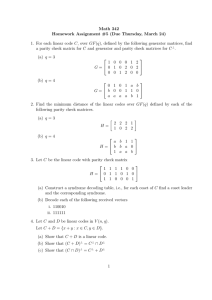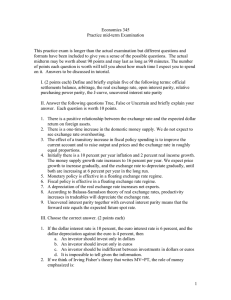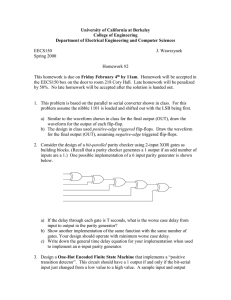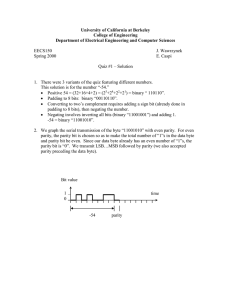Symmetries and Conservation Laws I Discreet Symmetries C, P, T
advertisement
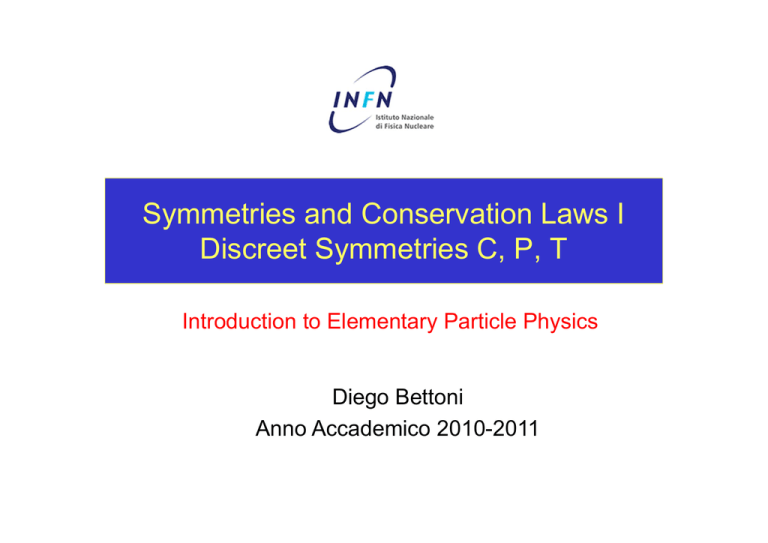
Symmetries and Conservation Laws I Discreet Symmetries C, P, T Introduction to Elementary Particle Physics Diego Bettoni Anno Accademico 2010-2011 Outline • Symmetries and Conservation Laws • Parity (P) • Charge Conjugation (C) – Particles and Antiparticles – Positronium Decay • Charge Conservation and Gauge Invariance • CPT • CP and Time Reversal (T) – Detailed balance Symmetries and Conservation Laws In Heisenberg representation the time dependence of the operator Q(t) is given by: Q dQ i i Q, H t dt An operator with no explicit time dependance is a constant of the motion if it commutes with the hamiltonian operator. In general, conserved quantum numbers are associated to operators commuting with the hamiltonian. Example: space translations ( r r ) ( r ) r 1 r r r ip D 1 r For a finite translation: ipr n ipr D lim 1 e n n P is the generator of the operator D of space translations. IF H is invariant under transations [D,H] =0 hence: [p,H] = 0 The following three statements are equivalent: •Momentum is conserved for an isolated system. •The hamiltonian is invariant under space translations. •The momentum operator commutes with the hamiltonian. Conservation Laws Strong E.M. Weak Energy/Momentum Electric Charge Baryon Number Lepton Number Isospin (I) Strangeness (S) Charm (C) Parity (P) Charge Conjugation (C) CP (or T) CPT Parity (P) The operation of spatial inversion of coordinates is produced by the parity operator P: P(r) (r) Repetition of this operation implies P2=1 so that P is a unitary operator. P P (r ) (r ) (r ) Therefore if there are parity eigenvalues they must be: P = ±1 Examples: P P = +1 ( x ) cos x cos( x ) cos x ( x ) P = -1 P ( x ) sin x sin( x ) sin x ( x ) P ( x ) sin x cos x sin x cos x ( x ) z Example: the hydrogen atom r ( 2l 1)( l m )! l ( r, , ) ( r ) Pm (cos )eim 4 (l m )! y π−θ r r e e im ( ) Yl (1) Yl l m m im (1) e Pl (cos ) (1) m m π+φ φ -r im θ l m Pl (cos ) m x Hence the spherical harmonics have parity P=(-1)l. For example, in electric dipole transitions, which obey the selection rule l = ±1, the atomic parity changes. Therefore the parity of the emitted radiation must be negative, in in order to conserve the total parity of the system atom+photon. P() = -1 P is a multiplicative quantum number. It is conserved in strong and elettromagnetic interactions, but it is not conserved in weak interactions. Parity conservation law requires the assignment of an intrinsic parity to each particle. Protons and neutrons are conventionally assigned positive parity Pp=Pn=+1 Parity The pion () is a spin 0 meson. Consider the reaction - + d n + n (where the deuteron d is a pn bound state). In the initial state l=0; since s=0, sd=1 the total angular momentum must be J=1 (J=L+S). Therefore also in the final state we must have J=1. The symmetry of the final state wave function (under interchange of the 2 neutrons) is given by: K ( 1) S 1 ( 1) L ( 1) L S 1 spin orbitale Since we have two identical fermions it must be K=-1, which implies L+S is even. With the condition J=1 we have the following possibilities: L=0 S=1 no L=1 S=0 no L=2 S=1 no L=1 S=1 OK Therefore the parity of the final state is P=(-1)L=-1. Since the parity of the deuteron is Pd=+1 we obtain for the intrinsic parity P = -1. The is therefore a pseudoscalar meson. Parity of the neutral pion (0) 0 B.R. = (99.798 ± 0.032) % Let k and -k be the momentum vectors of the two ; e1 and e2 their polarization vectors. The simplest linear combinations one can form which satisfy requirements of exchange symmetry for identical bosons are: 1 ( 2 ) A( e1 e2 ) cos 2 ( 2 ) B( e1 e2 ) k sin 1 is a scalar and therefore even under space inversion, 2 is a pseudoscalar and therefore it has odd parity. P 0 1 cos 2 2 P 0 1 sin 2 2 where is the angle between the polarization planes of the two . The experiment was done using the decay: 0 e e e e (double Dalitz; B.R. = (3.14 ± 0.30)10-5) in which each Dalitz pair lies predominantly in the polarization plane of the “internally converting” photon. The result is P0=-1. e e e e 0 The assignment of an intrinsic parity is meaningful when particles interact with one another (as in the case of electric charge). The nucleon intrinsic parity is a matter of convention. The relative parity of particle and antiparticle is not a matter of convention. Fermions and antifermions are created in pairs, for instance: p p p p p p whereas this is not the case for bosons. Fermions: particle and antiparticle have opposite parity. Bosons: particle and antiparticle have equal parity. r p E B r polar vectors p axial vector ( r p ) E B Parity Conservation Parity is conserved in strong and electromagnetic interactions, whereas it is violated in weak interactions. (V-A theory, maximal parity violation) Example: p σ σ P ν p ν In experimental studies of strong and electromagnetic interactions tiny degrees of parity violation are in fact observed, due to contributions from the weak interactions: H = Hs + Hem + Hw. Atomic transitions: O * 12C 16 J P 2 J P 2 with total witdth =(1.00.3)10-10 eV, to be compared with of width 310-3 eV. O * 16O 16 Particles and Antiparticles The relativistic relation between the total energy E, momentum p and rest mass m of a particle is: E p c m c 2 2 2 2 4 The total energy can assume negative as well as positive values: E p 2c 2 m 2c 4 In quantum mechanics we represent the amplitude of an infinite stream of particles, e.g. electrons, travelling along the positive x-axis with 3-momentum p by the plane wavefunction: Ae i ( Et px ) / Formally this expression can also represent particles of energy -E and momentum -p travelling in the negative x-direction and backwards in time. E>0 E<0 t t Such a stream of negative electrons flowing backwards in time is equivalent to positive charges flowing forward, and thus having E>0. The negative energy particle states are connected with the existence of positive energy antiparticles of exactly equal but opposite electrical charge and magnetic moment, and otherwise identical. B E>mc 2 0000000000000 1111111111111 the positron, the antiparticle of the electron, 0000000000000 1111111111111 0000000000000 1111111111111 0 1 2 was discovered experimentally in 1932 in 0 1 2mc E=0 0 1 0 1 cloud chamber experiments with cosmic rays. 0 1 1111111111111 0000000000000 0000000000000 1111111111111 0000000000000 1111111111111 2 A E<mc Charge Conjugation (C) Charge conjugation reverses the charge and magnetic moment of a particle. In classical physics Maxwell’s equations under: are invariant q q j j E E H H In relativistic quantum mechanics: p Q B particle antiparticle C +e +1 +2.79(e/2mc) ½ p σ -e -1 -2.79(e/2mc) ½ σ P ν CP σ σ ν p ν C p p ν p Eigenstates of the C Operator Only neutral bosons which are their own antiparticle can be eigenstates of C. C + e - are not C eigenstates. For the : C 0 0 2 1 C 0 0 0 C 1 0 Electromagnetic interactions conserve C, therefore the decay 0 3 should be forbidden. Experimentally we find: BR ( 0 3 ) 8 3 . 1 10 BR ( 0 2 ) Conservation of C Charge conjugation C is conserved in strong and electromagnetic interactions, but not in weak interaction. • Spectra of particle and antiparticle, for example: p+p + + - + .... p+p K+ + K- + .... • meson decay (JP = 0-, M = 550 MeV/c2) B.R. = (39.21 0.34) % B.R. + - 0 B.R. = (23.1 0.5) % + - B.R. = (4.77 0.13) % 0e+eB.R. < 4 10-5 Since we must have C=+1. Hence the decay 0e+e- is forbidden by C conservation. ch tot Positronium Decay Positronium is an e+e- bound state which possesses energy levels similar to the hydrogen atom (with about half the spacing). Wave function: (e+e-) = (space)(spin)(charge) (space) Particle interchange is equivalent to space inversion introducing a factor (-1)L where L is orbital angular momentum (spin) (1,1) 1 ( 12 , 12 ) 2 ( 12 , 12 ) 1 1 1 1 1 1 1 1 1 (1,0) 2 1 ( 2 , 2 ) 2 ( 2 , 2 ) 1 ( 2 , 2 ) 2 ( 2 , 2 ) (1,1) ( 1 , 1 ) ( 1 , 1 ) 1 2 2 2 2 2 1 1 1 1 (0,0) 2 1 ( 2 , 2 ) 2 ( 2 , 12 ) 1 ( 12 , 12 ) 2 ( 12 , 12 ) Triplet S=1 Symmetric Singlet S=0 Antisymmetric The symmetry of is therefore (-1)S+1 Let the charge wave function acquire a factor C. The total symmetry of the wave function for the interchange of e+ and e- is K= (-1)L(-1)S+1C Two decays are observed for positronium annihilation from L=0: (e+e-) 2 (e+e-) 3 The two-photon decay must have J=0, so the three-photon decays has to be assigned J=1. S=J L C K 2 0 0 +1 -1 3 1 0 -1 -1 (C = (-1)n for a system consisting of n photons). In QED the widths of these states can be calculated very accurately: 2 3 (theory) (experiment) 1 mc2 5 1.252 10 10 s (1.252 0.017) 10 10 s 2 2 ( 2 9) 6mc2 1.374 10 7 s (1.377 0.004) 10 7 s 9 Charge Conservation and Gauge Invariance Electric charge is known to be very accurately conserved in all processes. n p e e 24 9 10 n pe e The conservation of electric charge is related to the gauge invariance of the electromagnetic interaction. Wigner(1949): Suppose we create a charge Q at a point where the potential is . Let us now move the charge to a point where the potential is ’. W = Q(-’). Suppose we destroy the charge in this point. If W was the work done to create the charge, this work will be recovered when the charge is destroyed. Therefore we gain a net energy W-W+-’ because W does not depend on . The conservation of energy implies that we cannot create or destroy charge if the scale of electrostatic potential is arbitrary. A e e i ( k x t ) i ( p x Et ) B C e ipx Suppose we send a beam of electrons on a screen in which there are two slits A and B and that we observe the interference on a second screen C located at a distance d from the first. p ( E , p ) x (t , x ) c 1 Let us redefine by adding a phase -e. e ( ipxe ) The interference pattern on C depends only on phase differences and it is independent on the global phase e. If however e = e(x): i px e i p e x x And the result would seem to depend on the local phase transformation. Electrons however are charged and they interact via an electromagnetic potential, which we write as a 4-vector A: A ( , A) The effect of the potential is to change the phase of an electron: p p + eA So the derivative now becomes: i px eAx e ( x ) i p eA e x x The potential scale is also arbitrary and we can change it by adding to A the gradient of any scalar function (Gauge transformation): A A x With this transformation the derivative becomes ip, independent of (x). The effect of the original local phase transformation is cancelled exactly by the gauge transformation. A A ( x ) x Time Reversal (T) p Al Mg 27 24 t t r r p p E E B B T violation < 510-4 CPT CPT theorem: All interactions are invariant under the succession of the three operation C, P and T taken in any order. m(particle) = m(antiparticle) (particle) = (antiparticle) mK 0 mK 0 mK 0 mK 0 (particle)=- (antiparticle) 1019 104 mass lifetime e e 1012 e e magnetic moment CP In 1964 it was discovered that the long lived K0L, which normally decays into three pions (CP = -1), could occasionally decay into two pions (CP=+1). This result represents the discovery of CP violation. CP violation is at the origin of the asymmetry between matter and antimatter in our universe. CP violation is equivalent to T violation (via the CPT theorem). The following observables are sensitive to T violation: • Transverse polarization (p1p2) in weak decays such as + e+ e. Upper limits from these studies < 10-3. • Electric dipole moment E. Upper limit for the neutron: EDM(n) < 1.0 10-25 ecm Fermi’s Golden Rule d 2N n b n a vi dAdt W na vi W = number of interactions per unit time per target particle The cross section contains information on the interacting particles and on the interaction dynamics. If we write the hamiltonian as: H = H0 + H it can be shown that in first order perturbation theory: M if *f H i d it contains the interaction dynamics 2 dn 2 Fermi’s Golden Rule W M if dE0 dn final state density (phase space factor) dE0 2 ( 2 s 1)(2 s 1) 2 1 c d (a b c d ) 4 M if pf vi v f Principle of Detailed Balance a bc d From T and P invariance we obtain: 2 M if M fi 2 f ( pc , pd , sc , sd ) H i ( pa , pb , sa , sb ) T i ( pa , pb , sa , sb ) H f ( pc , pd , sc , sd ) P i ( pa , pb , sa , sb ) H f ( pc , pd , sc , sd ) Summing over all (2s+1) spin projections yields |Mif|2=|Mfi|2. If T and P invariance does not hold (e.g. weak interactions) the same result can be obtained using first order perturbation theory and the hermiticity of H. Spin of the Charged Pion () The spin of the charged pion was determined by applying detailed balance to the reversible reaction: p p d pp d M if d pp pp d d pp 2 2s 12sd 1 p 2 vi v f 2 factor ½ comes from the integration s 2 1 2 1 p 2 (the half solid angle, due to the fact that M fi p p over there are two identical bosons in the v f vi 2 final state). 2 s 12 sd 1 p2 2 2s 1 2 p Measuring the cross sections for the direct and reverse reactions one obtains: p 2p s 0 Spin of the Neutral Pion (0) For the neutral pion the decay 0 proves that the spin must be integral and that it cannot be one. For a photon (zero mass, spin 1) sz = 1. Taking the common line of flight of the photons in the 0 rest frame as the quantization axis, if S is the total spin of the two photons we can have: Sz = 0 oppure Sz = 2. If the 0 spin is 1, then Sz = 0. In this case the two-photon amplitude must behave under spatial rotations like the polynomial P01(cos), which is odd under the interchange of the two photons. But the wave function must be symmetric under the interchange of the two identical bosons, hence the 0 spin cannot be 1. In conclusion s = 0 or s 2.

